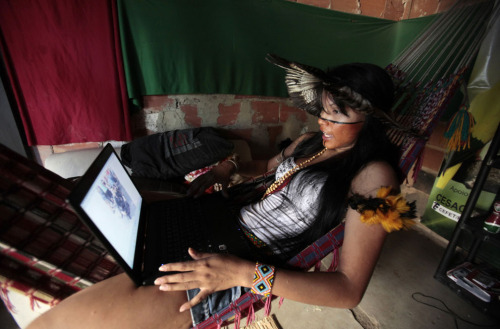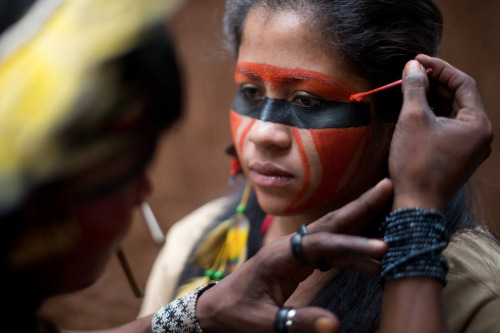
'Naitaavad enaa, paro anyad asti' (There is not merely this, but a transcendent other). Rgveda. X, 31.8.
210 posts
Latest Posts by prasannachoudhary - Page 6



On View: Imran Qureshi’s Rooftop Installation at the Metropolitan Museum
Pakistani artist Imran Qureshi’s installation And How Many Rains Must Fall Before the Stains are Washed Clean in The Metropolitan Museum of Art‘s Iris and B. Gerald Cantor Rooftop Garden is as arresting as it is unconventional. Delicate floral designs sprawl out across the museum’s rooftop, painted like a mural on the floor. The painstakingly-rendered flowers are drowned in crimson paint. The work’s delicate beauty becomes bittersweet, tainted by the violence of the red stains. Qureshi created the installation as an expression of sorrow for violence across the world; the floral patterns amid the blood-like splatters speak to a hope for regeneration. Take a look at some photos of Qureshi completing the work as well as the finished installation courtesy of The Metropolitan Museum of Art and Hyla Skopitz. The installation is on view at the Metropolitan Museum through November 3, weather permitting.
MORE: http://hifructose.com/2013/07/11/on-view-imran-qureshis-rooftop-installation-at-the-metropolitan-museum/

St. Mark’s Square II, Venice, 2007, Guy Sargent

CELLINI, Benvenuto
Perseus
1545-54
Bronze, height 320 cm
Loggia dei Lanzi, Florence

MANDELA: A CELEBRATION
July 15 to 20, 2013
The Schomburg Center for Research in Black Culture will mark Nelson Mandela’s birthday and Nelson Mandela International Day (July 18) with six days of commemoration.
Mandela: A Celebration is a special...







Black motorcycle clubs emerged throughout Cali in the 50s & 60s, and fought against racism and stereotypes of the day for their right to live the outlaw biker lifestyle — like the East Bay Dragons, Fresco Rattlers, Outlaw Vagabonds, Defiant Ones; down South in LA were the Choppers, Soul Brothers & of course, the Chosen Few.
via: the selvedge yard
*

Alfred Wertheimer’s never-before-seen photos of Elvis when he was a 21-year-old up-and-coming crooner.
Gettysburg
Reblogged from Flickr Blog:
"The Battle of Gettysburg was fought on July 1-3, 1863, at a small town in Pennsylvania. With an estimated 50,000 Confederate and Union casualties, the battle was a major turning point in the American Civil War."reads the…
View Post
Happy Birthday, Rousseau
For Rousseau’s birthday, 21 essential reads on education – Bertrand Russell, Susan Sontag, Noam Chomsky, Isaac Asimov, Kio Stark, Richard Feynman, and more:


It all comes down to that urge to fascism — maybe a big word to use for art, but I think the right word — it comes down to that urge to fascism to know what’s best for people, to know that some people are of the best and some people are of the worst; the urge to separate the good from the bad and to praise oneself; to decide what covers on what books people ought to read, what songs people ought to be moved by, what art they ought to make, an urge that makes art into a set of laws that take away your freedom rather than a kind of activity that creates freedom or reveals it. It all comes down to the notion that, in the end, there is a social explanation for art, which is to say an explanation of what kind of art you should be ashamed of and what kind of art you should be proud of. It’s the reduction of the mystery of art, where it comes from, where it goes…
When you step away from the prepackaged structure of traditional education, you’ll discover that there are many more ways to learn outside school than within.
Don’t Go Back to School (via explore-blog)

Adolph Gottlieb, Equinox, 1963
From the Phillips Collection:
Once he felt he had exhausted the myriad possibilities of his pictographs, Gottlieb began to simplify his symbols and composition in order to enhance his theme of universality. By the 1960s, he was creating paintings like Equinox, in which the grid is reduced to an implied (although occasionally delineated) horizontal division that separates the image into two halves. Within each half, a few shapes—circles, squares, or calligraphic gestures—float against a field of color, vying for focal supremacy. Gottlieb creates a tension between the two forms struggling against each other, but in their balance and containment within a field of color, he also achieves a harmonious resolution.
Duncan Phillips acquired his two examples of Gottlieb’s work soon after each was painted, evidence of his appreciation of his art. Although no specific reference to Gottlieb appears in Phillips’s surviving writings, he could have had Gottlieb in mind when he declared in 1955, “I admire the aesthetic interpretations of the age we live in—even the symbols for the anarchy, the turmoil and the inner tensions.”
Be contemporary. Have impact. Strive for it. Be of the world. Move it. Be bold, don’t hold back. Then the moment you think you’ve been bold, be bolder. We are all alive today, ever so briefly here now, not then, not ago, not in some dreamworld of a hypothetical future. Whatever you do, you must make it contemporary. Make it matter now. You must give us a new path to tread, even if it carries the footfalls of old soles. You must not be immune to the weird urgency of today.
Wisdom from Ian Bogost’s commencement address at the University of Iowa, a fine addition to this ongoing archive of timeless advice. Pair with Greil Marcus’s fantastic 2013 School of Visual Arts commencement address.
(↬ austinkleon)

Mummiform Figure of Osiris
The inscription identifies this figure as Osiris. He wears the crown of ostrich feathers, a sun-disk, and the ram’s horns that identify him as a king. Yet he is also in the form of a mummy with the curled beard worn by the dead. The figure stands on a hollow base. Originally, a papyrus with a spell written on it was stored in the base. When this figure and papyrus were placed in the tomb, the deceased enjoyed the protection of Osiris and of the spell.
Medium: Wood, painted
Place Made: Egypt
Dates: 664-332 B.C.E.
Period: Late Period (probably)
Brooklyn Museum

Isis, the Mother of Apis
Associated with fertility, generation, and resurrection, the Apis bull was prominent throughout the long history of ancient Egyptian religion. Originally the bull, as all other animals, was revered as the manifestation of certain divine powers and was not itself a deity. Later, however, the Apis was in fact worshiped. Through its connotations of potency and renewal, it was associated with the gods Ptah and Osiris and with royal ritual. Isis, the wife of Osiris, is shown here in her role as mother of Apis. She is identified by her long cow’s horns, distinct from the Apis’s shorter set. This bronze item may have been a finial or fitting for the end of a carrying pole that bore a portable shrine of the Apis.
Medium: Bronze
Place Made: Egypt
Dates: ca. 670-332 B.C.E.
Dynasty: late XXV Dynasty to early XXVI Dynasty
Period: Third Intermediate Period to Late Period
Brooklyn Museum
What I went looking for was an answer to a deeper question about the metaphoric holes left in a person, a family or a community by murderous acts, whether by guns, knives, or bare hands. If nothing else, talking about guns can serve as a beacon, starting me on the road toward answering the question: Why do Americans kill so much? […] There are two kinds of social capital—bonding and bridging—and each impact a society differently. Bonding capital is what you get within a given group. These tend to be closer and more reliable bonds that form the foundation of our social capital. Yet bonding social capital is not always positive: Tight-knit groups can turn insular, reaching their logical conclusion in gangs and militias but with negative effects found in everything from families to groups of friends to certain kinds of religious communities. In contrast, bridging social capital reaches across a societal divide such as race, region or religion and is by nature weak. But it also promotes empathy and tolerance and enlarges our radius of trust, allowing us to see other people as people, not as a faceless other. This sense of bridging a divide is especially important in the U.S. because, contrary to popular opinion, we regularly put the needs of the group ahead of the needs of the individual in a way Europeans don’t. In surveys, Western Europeans are more likely than Americans to say citizens should follow their conscience and break an unjust law or that citizens should defy their homeland if they believe their country is acting immorally. On the other hand, Americans are more likely to believe they control their own fate and to believe in a more laissez-faire relationship with the state. It’s a more complex mix than our myths allow for, and the end result is that it can be hard to fathom just how different Americans are from the rest of the world. […] Perhaps, like a true original sin, groups in power in the U.S. have systematically destroyed social capital in vulnerable communities and between groups of all kinds in order to gain wealth and power and deny it to others. And perhaps they have done this in more ruthless fashion than in other comparable cultures. This could explain why the murder rate in New York has been more than five times higher than London’s for 200 years, though the American propensity for violence reaches even farther back than that, going all the way back to frantic religious refugees with visions of the Apocalypse both at their back and before their eyes.
Bad Land – Nathan Hegendus explores the social psychology underpinning gun culture in America.
Also see Stephen King on gun control and violence.
(via explore-blog)










Indigenous people of Brazil trying to prevent their eviction from an old indigenous museum which they have been living in for the past 7 years.
On March 22nd all of the inhabitants and their supporters were forcibly removed or arrested.
The building is being destroyed to make a parking lot :(

John Ashbery, “Summer Dream.”
In 2008, Ashbery returned to collage work, an art form he hadn’t worked with since the 1970s. As Dan Chiasson wrote in issue 188’s portfolio, “Collage is an art of time, like poetry. … These collages are a collaboration across decades: like Ashbery’s poems, they are a way of keeping time an open question.”
One of the most significant intellectual errors educated persons make is in underestimating the fallibility of science. The very best scientific theories containing our soundest, most reliable knowledge are certain to be superseded, recategorized from “right” to “wrong”; they are, as physicist ...

Helen Levitt, Children with Soap Bubbles, New York City, c. 1945
From the Metropolitan Museum of Art:
Helen Levitt’s photographs of everyday life in her own New York neighborhood have epitomized domestic urban life for over sixty years. This image of children - one of her most common subjects - demonstrates Levitt’s astute portrayal of gesture, praised as “lyrical” by James Agee in the introduction to her book, A Way of Seeing. As the viewer’s attention echoes the children’s glance toward the left of the scene, the picture poses a riddle as to the bubbles’ source, transforming this gritty city street into a magical metropolitan playground.
“Incantation. A prayer for apps and the latest whatever, sung by “the witch”. New things to try, a desperation, an automation to it. A heaviness, as if being joined by a yoke to our technology, it’s dragging us, making us pay per download. We’re it’s slave.”
Leah Kardos’s album “Machines”, a song cycle based on themes of technology, loneliness and the human condition, with lyrics derived from spam emails. (via Tom A.)

PRINT - www.seetalsolanki.com

Mask
Tsimshian
1800-30
National Museum of the American Indian
Don’t aim at success — the more you aim at it and make it a target, the more you are going to miss it. For success, like happiness, cannot be pursued; it must ensue, and it only does so as the unintended side-effect of one’s dedication to a cause greater than oneself or as the by-product of one’s surrender to a person other than oneself. Happiness must happen, and the same holds for success: you have to let it happen by not caring about it. I want you to listen to what your conscience commands you to do and go on to carry it out to the best of your knowledge. Then you will live to see that in the long run—in the long run, I say!—success will follow you precisely because you had forgotten to think of it.
Viktor Frankl (via explore-blog)
A fresh-faced, best-selling author who pens raunchy tales of young professionals in India.
Egalite for All. Toussaint Louverture and the Haitian Revolution (PBS) PBS documentary on Toussaint Louverture and the Haitian Revolution. It was the only successful slave insurrection in history. It grasped the full meaning of French revolutionary ideas — liberté, eqalité, fraternité — and used them to create the world’s first Black republic. It changed the trajectory of colonial economics…and led to America’s acquisition of the Louisiana territory from France. “It” was the Haitian Revolution, a movement that’s been called the true birth moment of universal human rights. Vaguely remembered today, the Haitian Revolution was a hurricane at the turn of the nineteenth century — traumatizing Southern planters and inspiring slaves and abolitionists, worldwide.

Fall colors blaze out in concentric rings from a lake in eastern Pomerania, Poland. The region on the south shore of the Baltic Sea is largely covered with farmland and vast swaths of forest.
Source ((Travel 365, National Geographic)






Li Huayi, ink and color on paper








Miriam Makeba interview, 1969
Miriam Makeba (4 March 1932 – 10 November 2008), nicknamed Mama Africa, was a Grammy Award winning South African singer and civil rights activist. She actively campaigned against the South African system of apartheid. As a result, the South African government revoked her citizenship and right of return. After the end of apartheid she returned home.

Tiger Bay, Cardiff, 1950, Bert Hardy